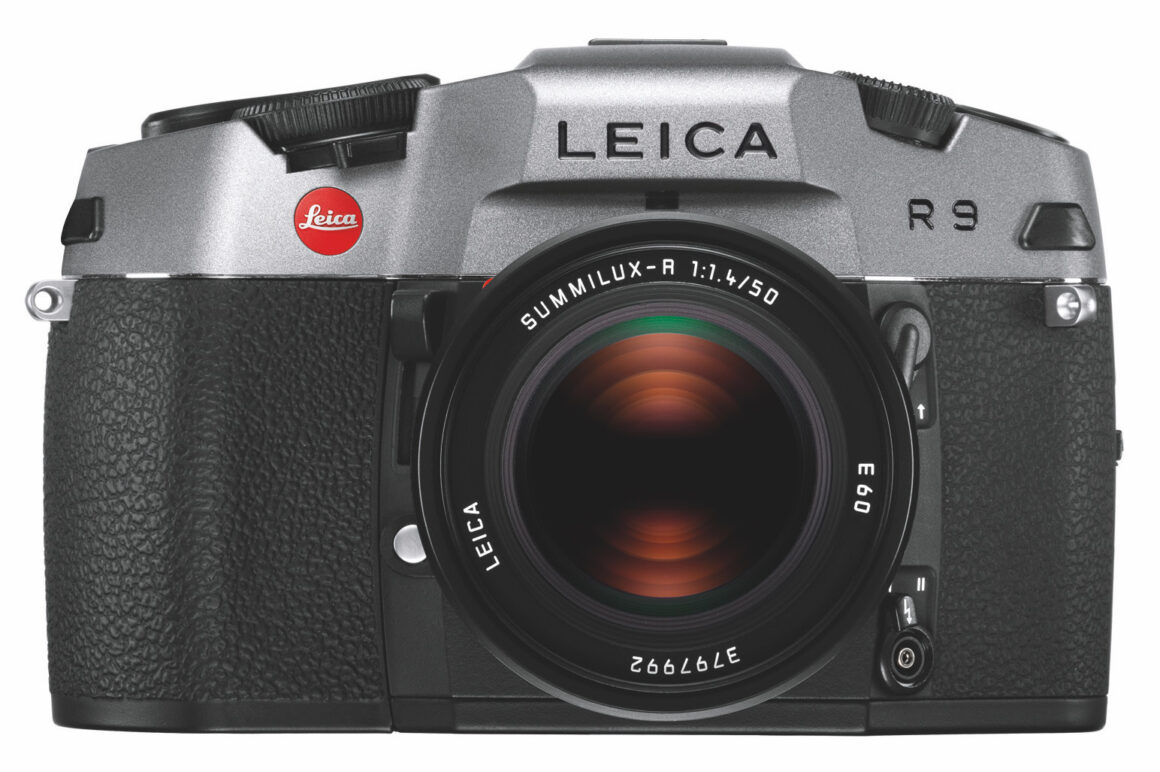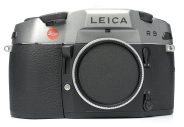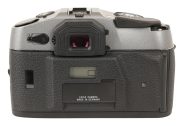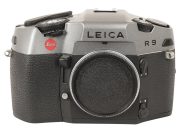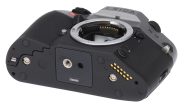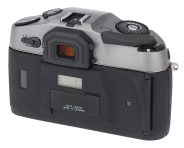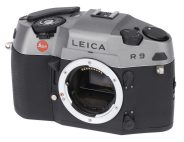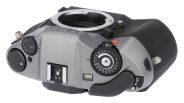Leica R9
35mm MF film SLR camera
Specification
| Production details: | |
| Announced: | 2002 |
| Order No.: | 10090 - anthracite finish |
| 10091 - black finish | |
| System: | ● Leica R (1964) |
| Format: | |
| Maximum format: | 35mm full frame |
| Film type: | 135 cartridge-loaded film |
| Mount and Flange focal distance: | Leica R [47mm] |
| Shutter: | |
| Type: | Focal-plane |
| Model: | Electronically controlled |
| Speeds: | 16 - 1/8000 + B |
| Exposure: | |
| Exposure metering: | Through-the-lens (TTL), open-aperture |
| Exposure modes: | Programmed Auto |
| Aperture-priority Auto | |
| Shutter-priority Auto | |
| Manual | |
| Physical characteristics: | |
| Weight: | 790g |
| Dimensions: | 158x101x62mm |
| Accessories: | |
| Body cap: | 14103 |
Manufacturer description #1
05 - 09/2002 - LEICA R9
At photokina 2002 in Cologne, Germany, Leica Camera AG introduced the LEICA R9, a single lens reflex camera that incorporates numerous enhanced characteristics that are important photographically. Thanks to the use of new materials such as magnesium, the new camera is 100 grams (just over 3 1/2 ounces) lighter than the current top-of-the-line model LEICA R8, yet it retains the very same rigidity. A new exposure counter on the top cover and additional information shown on the display on the back cover give the photographer an improved overview of all the important parameters. An innovative multi-pattern exposure metering system that adjusts in tenths of an f-stop further increases the high precision exposure metering for which the LEICA R8 was already recognized. An even more balanced control of flash exposures in the Program mode and the new capability of using flash with ultra-fast shutter speeds up to 1/8000 second expand the creative possibilities. The reliability of the camera, which was already high, was enhanced even further by means of useful details, such as an operating mode selector dial that now locks firmly in place.
“With the LEICA R9, Leica Camera AG is offering a new, further improved precision instrument for the 28 high-performance lenses of the Leica R single lens reflex assortment,” explains Stefan Daniel, manager of the business unit for system products. “Six years after the introduction of the LEICA R8, we assembled an extensive package of improvements that takes into account numerous suggestions made by professional and semi-professional users and that employs new technologies and processes.”
With the announcement of the LEICA R9 and the introduction of three new Leica R lenses in quick succession, Leica Camera AG substantiates its dedication to the high-grade single lens reflex system. In addition to the recently introduced 15 mm f/2.8 LEICA ELMARIT-R ASPH. and the 21-35 mm f/3.4-4 LEICA VARIO-ELMAR-R ASPH. lenses, Leica presented the new 90 mm f/2 LEICA APO-SUMMICRON ASPH. lens at Photokina. “To me, photography is only complete with the Leica R System,” stated Hanns-Peter Cohn, CEO of Leica Camera AG. “To work with the LEICA R9 means to explore anew the fascinating world of Leica R lenses. From macro shots to telephoto photography. From brilliant slides to superb exhibition prints”, added Cohn.
In conceiving the LEICA R9, the Solms camera designers followed the objective of providing photographers with the greatest possible creative freedom. In this context, the core philosophy was to concentrate on what is significant. “The LEICA R9 does not incorporate everything that is technically possible, but everything that makes sense – in Leica quality”, stated Stefan Daniel. With the LEICA R9, the photographer has all the photographic parameters under his or her control without being ‘patronized’ by features and functions. The uniquely bright viewfinder serves for positioning the plane of sharpness, controlling the depth of field and the cropping. Clearly readable and logically arranged control elements for shutter speeds and aperture are positioned where one would intuitively expect them to be. In conjunction with the world-renowned Leica high-performance lenses, the LEICA R9 offers “the photographic flexibility and freedom for the best 35 mm photographs in the world”, as Stefan Daniel describes it.
Every single LEICA R9 is a tool that is manufactured with meticulous manual craftsmanship. As a product ‘Made in Germany’, it stands for quality, precision and sturdiness. It embodies high technology – for instance through modern materials, sensible electronics and precise fabrication methods, which are the essence of dependable and value-retaining products. The decades-old concept of system compatibility also contributes to this distinguished image – virtually all Leica R lenses made since 1965 can be used on the LEICA R9.
Weight reduction by means of light metals. Weighing only 790 grams (less than 28 ounces), the LEICA R9 is 100 grams (more than 3 1/2 ounces) lighter than the LEICA R8. The lion’s share of the weight reduction was achieved by paring 70 grams (2 1/2 ounces) from the weight of the top cover. The magnesium top cover now weighs only 40 grams (less than 1 1/2 ounces), which is only about one third of the weight of the previous top cover, which was made of die-cast zinc. The rigidity of the new top cover is identical to that of the previous cover. Magnesium, the same material used for Formula 1 engines, was ideally suited for this weight reduction. The high Leica standards of longevity, however, required a research project in which Leica explored new technological domains.
Magnesium is particularly difficult to manage with respect to corrosion resistance and scuffing. Leica for the first time employs a plasma-chemical process for coating the light metal. This transforms the surface of the magnesium into a thin ceramic layer. In this process, special demands are placed on the magnesium alloy and on the preparation of the surface. Special lacquers are then applied to achieve an extraordinarily long-lasting finish. A greater fabrication effort is also required for casting the magnesium in the molds, because this takes place at temperatures of 700° C (1292° F) as compared to 400° C (752° F) in the die-casting process.
A reduction of another 30 grams (just over 1 ounce) was achieved mostly by using aluminum for the baseplate. The tripod socket, however, continues to be made of steel. This combination of steel and aluminum is particularly sturdy and it has the additional benefit of a slight dampening of vibrations when the LEICA R9 is used on a tripod.
As a result, the LEICA R9 now has the “ideal weight”, as Stefan Daniel describes it. “The camera is easier to transport and it continues to form a well-balanced unit with all the lenses, so that it can be hand-held very steadily in the great majority of situations.” The lower position of the center of gravity of the LEICA R9 leads to a particularly well-balanced fit in the hand. Elaborate design work achieved a solidity that makes the LEICA R9 optimally suited for extreme applications and many decades of good use.
Enhanced overview. A new, additional exposure counter was integrated into the top cover. It becomes active as soon as the camera is switched on. The counter is more legible in this location. Another new feature is the illumination of the back cover display, which facilitates making the settings, for instance when making time exposures in the dark. Even when the DX code reading is activated, this display always indicates the film speed.
Increased certainty. Because the operating mode selector dial now locks securely in the selected position, the new LEICA R9 provides increased certainty when it is being used in a hurry or in fast-moving action. The locking feature effectively prevents inadvertent changes of the selected setting of the operating mode. The scuff guards have also been optimized in such a way that the carrying strap will not rub the top plate. The highest dependability of the LEICA R9 is assured right from the start, because it benefited from all the improvements made during the life cycle of the LEICA R8. For that reason, Leica Camera AG has increased the warranty period of the LEICA R9 to three years.
Exposures with improved multi-pattern metering. A sensible exposure metering system with three specific metering methods on the LEICA R9 enables photographers to react appropriately to different light situations.
In multi-pattern exposure metering, prevailing light conditions are analyzed automatically and separately in six different areas. The resulting values are compared with pre-programmed types of subjects, from which an optimal exposure for the photograph is derived.
Another new feature of the LEICA R9 is the possibility of tailoring the multi-pattern metering to individual types of film in steps of tenths of an f-stop in the range of ±0.7 aperture stops. For example, with this feature, slide films can be exposed more sparingly and negative films more generously. In combination with Leica R lenses, which have a built-in ROM module that informs the camera of the aperture values measured individually for each separate lens, this achieves a unique precision and uniformity of exposure results. This is a decisive advantage for photographers who place the highest importance on accurate exposures, for instance for transparencies to be used in slide presentations.
Selective metering on the LEICA R9 covers a very small measuring field. It is used when backlit situations or extreme contrasts become a real challenge for the photographer. The metered value can be stored by gently pressing the shutter release button to the first pressure point long enough until the desired cropping has been selected.
Integral metering is used for scenes with balanced lighting. The complete picture area is measured with center-weighted metering, which is particularly suitable for subjects with a central point of interest. With this metering mode, the measured value can also be stored. This metering mode can be applied universally, but it is also ideally suited for judicious under- and over-exposures by activating the override switch without having to move the eye away from the viewfinder.
Operating modes. With its four operating modes that can be combined freely with the three metering modes, the LEICA R9 offers the flexibility that a versatile photographer requires for his or her photographic projects.
The variable program automatic exposure control mode P independently takes care of the correct exposure when the subject requires a fast reaction, or when the photographer wants to concentrate fully on the composition of the picture. Multi-pattern metering makes it possible to work very conveniently. In the neutral position P of the shutter speed dial, the subject is assigned a programmed combination of aperture and shutter speed based on the metered exposure value. When fast-moving subjects require a faster shutter speed, an appropriate combination of shutter speed and aperture can be obtained by turning the shutter speed dial to the desired speed. Of course this also applies to longer exposure times, for instance for deliberate motion blur in dynamic picture compositions.
In the shutter speed priority automatic exposure control mode T, numerous creative possibilities can be explored by selecting the appropriate shutter speed. This mode is particularly useful in sports photography. Fast-moving subjects can be frozen, the depth of field can be reduced deliberately. The camera automatically sets the correct aperture.
The aperture priority automatic exposure control A, the emphasis is on the creative use of the depth of field. The photographer manually selects the aperture and the camera determines the appropriate shutter speed.
In the manual operating mode m, all the parameters are controlled by the photographer. Especially in difficult light conditions, the photographer can select an f-stop with the aperture ring of the lens and a shutter speed with the shutter speed dial on the camera. A light balance in the viewfinder provides the necessary information for fine-tuning the exposure.
Improved flash operation. The expanded possibilities for photography with flash provide the photographer with greater creative latitude. With the new High Speed Synchronization (HSS), flash synchronization is possible with shutter speeds up to 1/8000 second. Even though the metal blade shutter is never completely open, uniform illumination of the entire frame is achieved by means of an extremely fast succession of several flashes. HSS flashing can also be used as fill-in flash on subjects in daylight. This process, also known as linear flash, is particularly advantageous for brightening portrait subjects out in the open. A wide open aperture – which leads to a beautiful sharpness-unsharpness transition – usually requires very fast shutter speeds, so that conventional flash synchronization speeds normally required for fill-in illumination are not applicable. The exposure is determined by means of a pre-flash with selective exposure metering of the main subject. HSS flashing is possible only in conjunction with the Metz Mecablitz 54 MZ-3 flash unit in combination with an SCA 3502 M3 adapter.
Because of improved control, the LEICA R9 also produces a more uniform exposure with flash photography in the variable program automatic exposure control mode. Ambient light is now taken into account more actively than before. Especially in twilight situations, a larger aperture and longer exposure times combined with flash can yield pictorial results with impressive moods.
In the flash exposure mode F, the LEICA R8 and the LEICA R9 share the unique capability of flash exposure metering before the actual exposure is made. In this case, the flash is metered in the selective mode. The result can be read in the over- and under-exposure indicator in the back cover display and it can be adjusted quickly by setting the aperture manually. This makes it possible to tailor the flash illumination very deliberately to suit decisive details of the subject.
The first quantities of the LEICA R9 will be available at photo dealers beginning in Oktober 2002. The new camera will be available with black or anthracite lacquer finish.
Manufacturer description #2
The LEICA R9 is the core of a superbly refined camera system. When you work with film, the camera can be customized by selecting one of a number of different film advance devices: the extremely compact and quiet manual film advance, or the inconspicuous LEICA MOTOR-WINDER R9, or the professional LEICA MOTOR-DRIVE R9. You even have a choice of colors for your camera: discreet black or elegant anthracite.
Accurate exposure metering and control are prerequisites for successful photographs. The LEICA R9 features selective, integral as well as sophisticated multi-pattern exposure metering whose level can be changed at any time by tenths of a step. The result: optimal harmonization with the various types of films. Metered value storage can be used with selective and integral metering. The selected shutter speed and aperture combination is automatically stored when the shutter release button is pressed to the second pressure point. The various exposure modes enhance flexibility, quickness and not least, your creative freedom.
Thanks to its R bayonet, the LEICA R9 is compatible with virtually all R lenses made since 1965. All current Leica R lenses are equipped with an ROM module, which establishes specific communication between camera and lens, leading to perfect exposures.
With the high-eyepoint viewfinder you no longer need to press your eye against the eyecup in order to see the image clearly all the way into its corners. And all the important parameters are displayed optimally in the viewfinder: Shutter speed, aperture, operating mode, exposure metering mode and the exposure counter. An important feature for time exposures: An integrated shutter prevents light from reaching the film through the eyepiece. Eyeglass wearers will be especially pleased with the diopter compensation range from –2 to +2 in half steps, enabling the photographer to focus and expose with or without using the eyeglasses.
The LEICA DIGITAL-MODUL-R can be attached to the LEICA R9 with a simple hand motion, thus transforming it into a full-function digital SLR camera. During the development phase, special attention was paid to optimal image quality. You simply decide whether analog or digital photography is best for the application. No need for you to change your way of shooting: meaning that the proven simple and logical operating concept that is so typical of Leica, is retained in the LEICA DIGITAL-MODUL-R camera and digital back neatly merge into a single unit.
All operating elements of the LEICA R9 are positioned very conveniently and can be operated intuitively, without moving the eye away from the viewfinder. The rugged metal body fits very nicely in your hands and it has ideal weight. Small details – important effects: The operating mode selector dial can now be locked in place to prevent unintended changes of your selected settings that may occur, for instance, in the carrying case. The eyecup too, can be locked in place, so that it won’t get lost.
The LEICA R9 provides you with three exposure options for flash photography. In addition to the fully automatic P mode and the selective flash mode F, it also features High Speed Synchronization (HSS). In combination with an HSS flash unit, it allows flash exposures with shutter speeds as high as 1/8000 second! This enables you to make pleasing portraits even in daylight and at full aperture, without harsh contrasts.
From the editor
An improved version of the R8 with a similar specification.
Compared to the R8, the weight was reduced by 100g mainly by making the top cover from magnesium alloy instead of die-cast zinc, and also by using aluminium for the base plate.
In late 2004 the Leica DIGITAL-MODUL-R became available to convert the R8 into a high performance digital camera.
